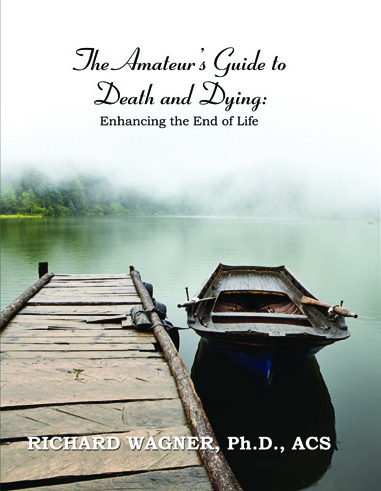More marvelous news! The second amazing review of The Amateur’s Guide To Death and Dying; Enhancing the End of Life has appeared in as many days.
The Amateur’s Guide to Death and Dying
Review by Emilie Collyer
‘None of the hard times I’ve seen, and I’ve seen plenty, lasted forever. Even this dying business will be over one day. I’ll just wake up dead one morning and that will that. What can I tell you?’
So says Max, an 86 year old man dying from stomach cancer. He’s one of ten group members you’ll meet and get to know when reading The Amateur’s Guide to Death and Dying.
The book is written by Richard Wagner who runs a non profit organisation called PARADIGM Programs Inc whose mission is ‘enhancing the end of life’. One of the main initiatives of the organisation is a ten week structured support program that focuses on death and dying. It is primarily targeted at people diagnosed with a terminal illness, but anyone can do the course.
The Amateur’s Guide to Death and Dying is a ‘workbook’ that takes the reader through the course. There are ten chapters that cover a wide range of territory. It is presented as a combination of group sessions, homework tasks and reflection exercises. There is a detailed blurb about each person and from then on we ‘hear’ from them in the first person, as if they are speaking directly to us in a group situation. They are fictional creations, but based on amalgams of real people. Wagner evokes their personalities well. I felt like I was hearing from ten distinct voices.
The content is comprehensive. We start with a discussion about perceptions of death, including why it still seems to be a taboo subject for so many people. Raul, 18, has polycystic kidney disease. He says how sick he is of ‘fightin’ something I can’t win.’ He hasn’t told his parents about attending the group because he knows how scared they are to accept the fact that he won’t live a long life: ‘They want me to keep praying to all these saints for some kinda stupid miracle. There are so many saints I can’t even remember all their names.’
From there, chapters move through many subjects and tasks including: writing your own obituary, legal, medical and financial matters, sexuality and body image for people who are dying, spirituality and belief, what happens to the body when we die, and the question of assisted, or pro-active dying.
The book is not always an easy read. It opens up questions about our own lives, including regrets and lost chances: ‘I haven’t done anything extraordinary, never won an award, never had my picture in the paper, never went to college, never even had a real job. I’m just an old woman who hasn’t anything to show for her life. And that makes me sad,’ says Janice, 62.
Reading such personal and intense stories has a significant emotional impact. I had to read slowly and take time out on occasion. And of course each story, task and provocation is designed to bring to the surface our own fears, hopes and regrets about death. This is a stated goal of the book and Wagner’s work in general. He is seeking a radical shift in how we perceive dying, specifically in terms of integrating it more consciously into every day life.
It’s not just about increasing awareness. Wagner believes we can live more full lives by embracing death. One of his motivations for creating the program and the book was because: ‘… the wisdom people come to during the dying process often died with them. There simply wasn’t a medium for collecting this abundant wisdom and thus it was frequently lost.’
There is a satisfying narrative arc to the book. Each of the participants comes to a sense of peace and acceptance about their situation. Many have renewed hope and vigour. ‘I feel like I’ve been able to look death in the face these past ten weeks and I didn’t flinch. So maybe, just maybe, death is not so foreboding after all,’ says Kevin, 39.
Some of the final statements in the evaluation section are a little pat. The book allows a neatness and sense of conclusion that is generally lacking in life with all its messiness. This is a minor point though, as the book’s content never shies away from the difficult and the unresolved.
The Amateur’s Guide to Death and Dying is a useful and practical tool for any person approaching their own death, or the death of a loved one and would make a valuable resource for health and community organisations working in this area.
Spending focussed time meditating on the end of life is not something we do often. It’s confronting to face our own mortality, but there’s something vital, even exhilarating about the brief moments of insight that can come. I’d recommend The Amateur’s Guide to Death and Dying to anyone seeking to engage with questions about death and the meaning of life.
Full Review HERE!

